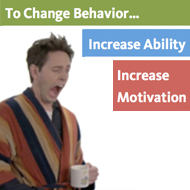changing lifestyles
Content
 Goal: Understand how your product’s design (not marketing) can change user behavior to improve sustainability, and why persuasive design requires ethical responsibility.
Goal: Understand how your product’s design (not marketing) can change user behavior to improve sustainability, and why persuasive design requires ethical responsibility.
Most people want to be good people: healthy, helpful, and leaving the world a little better than it was before. But most of us also have a hard time doing that. As designers, we can change user behavior towards more sustainable lifestyles: dropping throwaway consumerism in favor of sharing, maintenance, and reuse; walking or biking instead of driving; turning off lights, etc. For example, the average European has roughly half the environmental footprint of the average American not because of better engineering, but because of lifestyle: living in multi-unit housing close to work and shops radically reduces the car trips, road infrastructure, building energy, and building material per person.
How can you change your user’s behavior? Persuasive design is the art of making your product’s user interactions nudge people in a desired direction. This can be subtle or powerful, and requires ethical consideration to ensure you’re helping your users, not hurting them. Here are three videos showing:
- Potential benefits of persuasive design.
- Strategies for increasing the user’s ability to do the desired behavior.
- Strategies for increasing the user’s motivation to do the desired behavior.
Introduction to persuasive design
You can also download a PDF summary of the videos above in the following Autodesk Quick Reference Guide.
Autodesk Quick Reference Guide
Many people have created resources for persuasive design. They have different taxonomies to categorize persuasive design strategies, but the best strategy for you always depends on your product, user, and specific context. Here are some great sources:
- Persuasive Technology: Using Computers to Change What We Think and Do, book by B.J. Fogg. This is the book that launched the field of persuasive design.
- Design With Intent flashcards by Dan Lockton. These cards act as a random-access design guide, suggesting strategies by category.
- Behavioral Dynamics Institute’s video. This is another simple video introduction to influencing behavior in design.
- Evil By Design by Chris Nodder. This website and book also act as a design guide, cheekily reminding you to stay ethical.
- Mobile Persuasion: 20 Perspectives of the Future of Behavior Change, by B.J. Fogg. This book focuses specifically on persuasion through mobile apps and devices.
- Influence: the psychology of persuasion, by Robert Cialdini. A definitive text on the psychology of persuasion; you can determine how to apply it to design.
- Don’t Shoot The Dog!: the new art of teaching and training, by Karen Pryor. A valuable text on the psychology of behavior change; you can determine how to apply it to design.
All VentureWell Tools for Design and Sustainability content is shareable and usable by CC BY-NC-SA 4.0 license.
